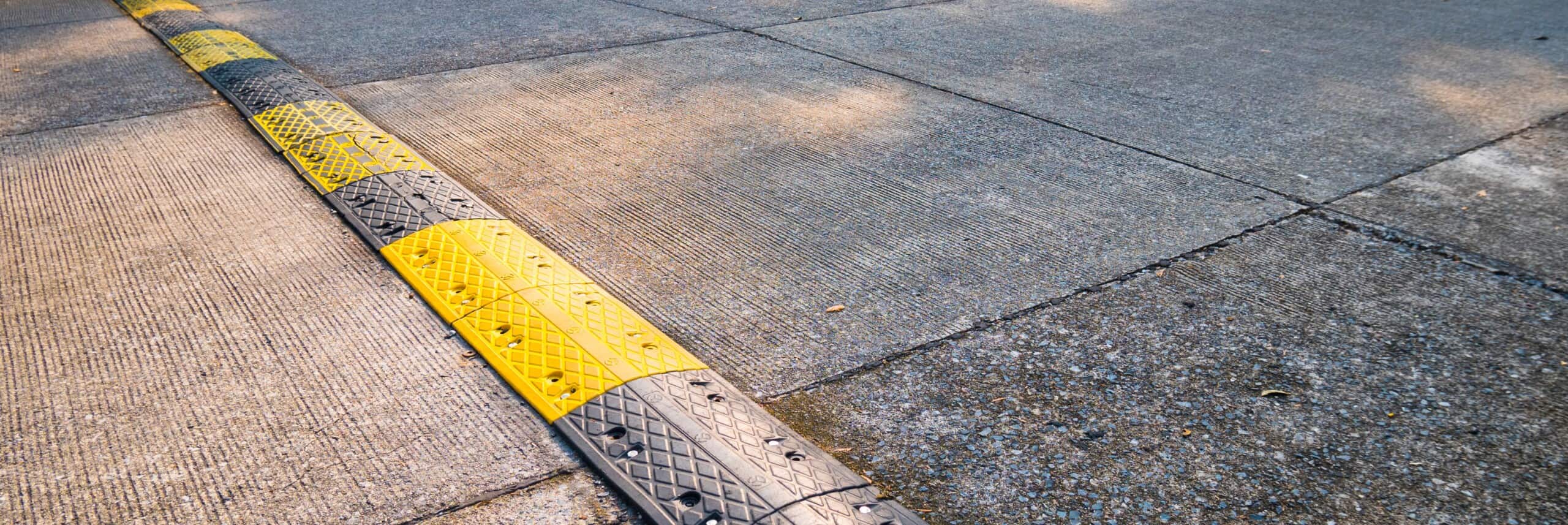Speed Bump Regulations

The Importance of Speed Bumps
Speed bumps are proven to be an effective traffic control method, reducing collisions and lowering the severity of accidents when they occur. If a person on your property is involved in an accident; they could become seriously injured or worse. Situations like this can leave your company open to hefty lawsuits, so it’s in everyone’s best interest that measures to prevent accidents are put into place wherever possible.
Installing speed bumps on your property is a great way to significantly reduce risk to pedestrians and your employees. However, if a speed bump is set up incorrectly, it can actually prove to be more hazardous than safe.
Speed Bump Regulations
The Highways (Road humps) Regulations 1999 specifies the standards which currently need to be met by law for the installation of speed bumps in England and Wales.
Consulting the Appropriate Bodies
Prior to any speed bumps being installed, you are required by law to first consult the chief officer of police for your local council, and also the chief officers of your local fire brigade and ambulance services. This is to ensure that proposed speed bumps won’t interfere with routes used by relevant service vehicles. If a speed bump has the potential to disrupt movement on a road, then the installation proposal may be rejected.
Another legal requirement is that you notify any organisations that use the road in question, such as busses, waste collection groups, maintenance services and traders. If you plan to install a speed bump on a private road; you must also consult with residents who share that road with you.
Dimensions and Locations of Speed Bumps
Speed bumps have the potential to damage vehicles and even make roads hazardous, and so there are regulations which must be adhered to.
Dimensions
- All speed bumps must be at least 900mm in length.
- The minimum height for a speed bump is 25mm at its highest point.
- The maximum height for a speed bump is 100mm at its highest point
- No vertical face or material forming the speed hump may exceed 6mm.
- The gradient of a speed bump must be no more than 1:10, however, you may need to consider a shallower gradient if the route is used by service vehicles to prevent vehicle grounding.
Location
- Speed bumps must always be placed at a right angle to an imaginary line which runs down the centre of a road.
- You may only install speed bumps on roads where the speed limit is lower than 30mph.
- You may not install speed bumps within 30 meters of the zebra-controlled area as defined by the Zebra, Pelican and Puffin Pedestrian Crossings Regulations and General Directions 1997. This does not apply to highway bodies.
Location (For zones where the speed limit is more than 20mph)
- You may not place a speed bump within 20 meters of a railway track at a crossing.
- Speed bumps are not to be placed within 2 meters of rail which provides support for vehicle carried on flanged wheels.
- Speed bumps cannot be placed under or within 25 meters of a structure which runs over a carriageway that is 6.5m high or less, from the surface of a carriageway.
- Speed bumps cannot be placed within 25 meters of a bridge where a highway or any part of the tunnel, culvert or related structure crosses the path of a highway.
Lighting of Speed Bumps
Lighting of roads is only compulsory where the speed limit exceeds 20mph.
In zones where the legal speed limit exceeds 20mph;
- Speed bumps cannot be used in areas where there is no street lighting.
- There must be a lighting system with at least three street lamps distanced no further than 38m apart to the next one along.
Placing of Traffic Signs
Traffic signs are only compulsory on roads where the speed limit exceeds 20mph, although it is recommended that signs be placed on all roads with speed bumps. There are no regulations as to how a sign should be placed, but anyone installing a speed bump is responsible for placing signs in a position with clear visibility and allows enough time for a driver to react to the sign.
Conclusion
When installing speed bumps on a commercial or private property, there are regulations that must be adhered to. On roads where the speed limit exceeds 20mph there are more regulations to be considered. Installing speed bumps is a great way to improve safety to the public and also your employees.
Considering installing speed bumps? You can view our commercial and domestic speed bumps here.
Have a Question? Contact Us!
Please Note:
The above article is our interpretation of the stated regulations and is intended for broad guidance and entertainment only. We do not pass ourselves off as an authority on the legalities of Speed Bumps. We are, therefore, unable to offer advice or become involved in disputes, accidents or local planning matters.
